What is the best set of poles for hiking and backpacking? We took twenty of the best poles and tested them head-to-head to in order to find out. We took these poles walking up big approaches in the Cascades on traditional trails, burly cross-country routes, and on snow. We also tested them on shorter hikes with both heavy and lighter loads while day hiking to see if we could feel a difference most often switching out between a half dozen (or more) poles systematically throughout the day. We evaluated them by the following criteria: the comfort of the grip and strap, packability and compactness, ease of use, durability, weight, and overall versatility.
If you are like a lot of people new to using hiking poles, you may be wondering “Why do I even need poles for hiking?” Well, you do! Poles help to reduce the impact on your body, to maintain balance and they can be used as a defense against wild animals or anything that might appear in your way. Among other benefits.
Best Overall Trekking Pole: Black Diamond Alpine Carbon Cork
The Black Diamond Alpine Carbon Cork is our top pick because it is fairly light, and is an extremely durable, comfortable, and versatile product. While the Alpine Carbon Cork isn’t as light or as compact as any of the folding “tentpole” style options, it is one of the more comfortable poles and is far tougher than the folding options. We think if you’re a climber or you engage in other activities where you have to carry your poles, then there are better options; however, we think that most folks are going to have their poles in their hands (rather than strapped to their pack) the majority of the time.
Best Value: Black Diamond Trail Back
- Excellent locking mechanism
- Very durable
- Comfortable and secure handle
Our best value pick goes to the Black Diamond Trail Back. The Trail Back is close in performance to many of the expensive poles (in several categories), but is less than half the cost of several of these award winners. While it isn’t the lightest or the most compact, it is a durable, versatile product that will meet most peoples needs and is by far our favorite pole in its price range. The Black Diamond Distance Z ($100) was a super strong contender because it’s far lighter, more packable, and features a more comfortable grip, but is also $20 more. We do think if you’re willing to spend $100 instead of $80, we’d probably go with the Distance Z. If budget comfort is what your after: the other excellent more price pointed pole is the Leki Cristallo which features a pretty darn comfortable handle and is possibly more durable, but also checks in with a $120 price tag.
Best For Comfort and Versatility: Leki Carbon Ti
- Lightweight
- Most comfortable foam grip
- Sticky lower grip is very functional
- Extremely durable
The Leki Carbon Ti was one of our favorite competitors in the review and only narrowly missed our choice as being the best overall. It remains a strong contender being near as versatile and offering what we considered a nicer and more ergonomic overall grip. If you’re someone who “palms” their poles, then the Carbon Ti’s fantastic oval-shaped handle will easily win you over. The Carbon Ti also weighs in one ounce lighter than our Editors’ Choice, the Black Diamond Alpine Carbon Cork and uses a bomber lever lock mechanism.
Best Lightweight Pole: Black Diamond Distance Carbon Z
- Incredible weight-to-solidity ratio
- Excellent fold system
- Great durability
- Lightweight
The Black Diamond Distance Carbon Z was the obvious winner for the Best Lightweight Hiking Pole and gets one of our Top Pick awards. When you pick up the Carbon Distance Z in terms of weight, it is noticeably lighter than the Leki Micro Stick, with very little compromise in toughness. Although it is bulkier and heavier than the Raidlight Foldable Trail, its vastly superior overall durability more than made up for the four ounces of weight difference. Also, we found that the Ultra Distance had better rigidity and greater strength which was an asset on the trail and mostly outweighed the hassle of a slightly longer (though still shorter than all other poles) folded length and bulkier handle when compared to the Raidlight.
Most Comfortable Folding Pole: Leki Micro Vario Ti COR-TEC
The Leki Micro Vario Ti COR-TEC gets one of our Top Pick awards for having the most comfortably designed and ergonomic cork handle that was our testers favorite in a pole that collapses to a review small of 15″. While it’s only average in weight (18 ounces), the Micro Vario’s overall design will be appreciated by, climbers, trekkers and backpackers alike and is reasonably priced at $140.
Best All-Arounder: Black Diamond Alpine Carbon Z
The Alpine Carbon Z poles were a strong contender for our Editors’ Choice award and were only just barely edged out for the Alpine Carbon Cork because they weren’t quite as durable nor did they offer any range of adjustment for a very similar weight. The Alpine Carbon Z remains one of our top scoring poles, featuring an equally comfortable grip, similar weight, and superior packability. While we thought the Alpine Carbon Z was more than durable enough for most hiking applications and the most versatile of any of the Z series of poles, it wasn’t quite as tough or as versatile as the Alpine Carbon Cork.
Best trekking poles – Table of Content
There are hundreds of hiking poles on the market today. After extensive research, we narrowed the field down to twenty of the best. The following explains what we found.
Criteria for Evaluation
Pole Adjustment Mechanism & Ease of Use
After extensively reviewing of all the different types and designs of locking and pole adjustment mechanisms, we found we liked the external lever-lock style mechanisms a lot better than most of the twist lock style mechanisms because they were more durable and easier to use.
Unlike just two years ago, when there was a small minority of pole manufacturers using lever lock style poles, now a majority of manufacturers use them, including most of the pole manufacturers in this review. Is there still an advantage to twist lock style poles? The answer is yes; twist lock style mechanisms are lighter, tend to need less adjusting over time and are less bulky. These were all small differences, but the much greater advantage of the lever style mechanisms ease-of-use and durability was enough for us to favor them.
The Black Diamond Distance Z has a Pushbutton or push-pop locking mechanism. While this system is no-frills and pretty basic, we found it very functional and extremely durable. Its only disadvantage is that it offered no range of adjustment.
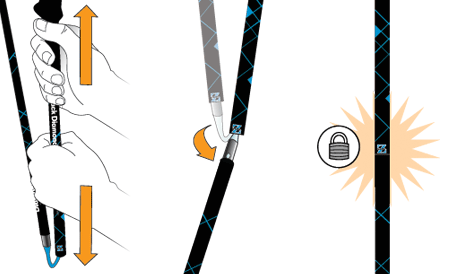
Even just a few years ago we used to prefer Black Diamond’s FlickLock system, but recently many pole manufacturers have answered back with better and better lever-locking style mechanisms (Black Diamond has also continued to update their own FlickLock system).
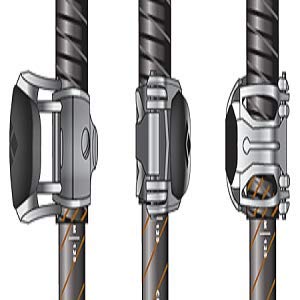
Most recently Leki released their updated SpeedLock 2 external lever locking system which proved equally as durable and reliable as BD’s FlickLock. The SpeedLock on top of being equally as functional proved to be the easiest external locking mechanism to adjust the tension of; no coin or special tool is needed and we found it easy to do with a bare or gloved hand.
While we tend to like external lever locking systems better overall, not all twist lock systems are created equal (and there are some BAD ones out there). By far our favorite twist lock mechanism was the one Leki uses on the Carbonlite poles. We found this mechanism to just plain last longer and proved more reliable over time.
Previously the Black Diamond Flick had been a runaway winner for functionality and durability, but now it faces as stiff of competition as ever. Currently, we think the Leki SpeedLock is equally as reliable but features the added advantage of the easiest-to-adjust tension of any pole mechanism in our review.
A new contender to the pole adjustment mechanism world is the “pin-pop” (or push button/push pin) style. Most of these are pretty basic but very functional and extremely durable. Many of the pin popo mechanisms are found in the Z-series or folding/collapsing-style folding poles like the Black Diamond Distance Carbon Z or the Leki Vario series like the Leki Micro Vario Carbon or Leki Micro Vario Ti COR-TEC. Some of these poles, like the Leki Micro Vario Ti COR-TEC, and Black Diamond Distance FLZ, feature two different systems, a pin pop to erect the pole and a single additional lever-lock system to add around 20 cm of adjustment.
Weight
By far the lightest poles in our review are the Raidlight Foldable Trail Pole at 6.3 ounces per pair. These poles have reached a near unseen level in weight for a collapsible hiking pole. While these four section poles are well made and stiffer than you might think, they aren’t intended for heavier duty hikes, burly or extensive off-trail travel, or steeper, rocky treks. We do think the Black Diamond Distance Carbon Z at a scant 10 ounces (for the 110 cm size) still feel crazy light when you pick them up and are tough enough for most backpackers, trekkers or climbers (except you can’t put snow baskets on them) though they offer essentially nothing in the way of height adjustment and still aren’t nearly as tough as more traditional telescoping poles (though we haven’t broken ours yet and have used them a lot). Another note about the lack of adjustment on the Distance Carbon Z (available in 100, 110, 120 and 130 cm sizes) is that we found after extensive use, that this wasn’t as much of a big deal as long as you purchased the correct size, to begin with, because for a majority of treks we found we rarely adjusted our poles.
Another one of our favorite poles were the Komperdell C3 Carbon Compact, at 13.5 ounces they are light, fully adjustable poles and are certainly a step up in durability from the Black Diamond Ultra Distance. We do feel that the Black Diamond Alpine Carbon Cork (16 ounces), and the Leki Carbon Ti (15 ounces) are a little more durable, but both are heavier.
The difference in weight between poles might not seem like a lot at first, even in our review the maximum difference is 16 ounces. But consider you are lifting your arm up thousands of times per day, potentially 10,000 or more times on a multi-day trip, and this is where the weight savings and reduced fatigue can really add up, so don’t just brush off the lighter poles because they are only 5-10 ounces lighter.
Among the aluminum telescoping poles the super price pointed REI Traverse Trekking Poles tipped the scales the same as the Leki Micro Stick at 17.5 ounces and the REI Traverse Shocklight is only one ounce heavier, adds a shock absorbing mechanism and is only $10 more expensive. We did think that the Leki Corklite felt much lighter in our hands on long treks than its 19 ounces might have to lead us to believe.
Comfort
The comfort of the pole handle is derived from its ergonomics, material and to a lesser extent its straps. We weight comfort higher than other categories, such as packability, because it is simply more important to a larger range of users and testers. Obviously, comfort is an important factor, and we could instantly feel a difference among all the poles we tested, but to what degree you can feel the difference varies from user to user. For folks who find themselves wearing gloves more of the time (for instance snowshoers and mountaineers), we found that it matters less, but still enough to make it one of our primary criteria for evaluation.
The Leki Carbon Ti was another one of our top contenders for its super comfortable and lower diameter foam grip coupled with lightweight and durable construction. Some of our testers, especially those with smaller hands or who frequent warmer climates, actually prefer the Carbon Ti’s handle to the Alpine Carbon Cork.
Trekking into Aconcagua’s Plaza De Mulas while working comparing and contrasting models side-by-side for this review.
Ergonomics
The format of the pole is one of the most important things to determine how comfortable a ple is. Regarding the most “comfortable” shape of a pole, we pooled our friends and testing them as open-mindedly as we could. After years of testing, no matter which way we held our pole, the Leki Corklite and the Leki Micro Vario Ti COR-TEC (which offer identical grips), are our favorite. It wasn’t the runaway favorite, but a clear-cut winner. We also really liked the Editors’ Choice Black Diamond Alpine Carbon Cork, Leki Carbon Ti, the Black Diamond Trail Ergo Cork, Leki Micro Vario Carbon, Alpine Carbon Z, and the Leki Carbonlite, but our testers straight up loved the Corklite.
All the Leki poles had fantastic ergonomics and cork grips that only improved with time. The Black Diamond Alpine Carbon Cork and Trail Ergo Cork didn’t feel quite as good at first but eventually broke in (more than the Leki poles) to make them just as comfortable. One last consideration is the diameter. The Black Diamond cork handled poles are certainly larger in diameter compared to either of their foam grip poles, (which also were the narrowest) or the Leki Corklite and Leki Micro Vario Ti COR-TEC, which featured the smallest diameter cork handle.
Grip Diameter
The diameter of a grip can vary a lot from model to model and manufacturer to manufacturer. If you have a smaller or larger than average hand grip diameter, this can possibly be the biggest contributing factor to a poles level of comfort than any of the other points mentioned above. If you have large or larger than average hands, the grips on the Komperdell C3 Carbon are certainly grittier than normal and awesome for big hands, but certainly not as good for smaller hands.
The Leki Corklite and the Black Diamond Alpine Carbon Z both feature slightly narrower-than-average grips that nearly all of our smaller handed testers preferred compared with the larger Alpine Carbon Cork and Trail Cork Ergo. Other great options for smallest diameter handles are the Black Diamond Distance Z, Distance Carbon Z, and Trail Back, along with the Leki Corklite and Carbonlite poles. For most people, if you have to go with a grip that’s a little too narrow, it’s a lot better than a grip that’s a little too big. If you’re looking for the best combination of the lightest pole with the most comfortable handle, check out the 14.5 ounces adjustable Leki Micro Vario Carbon.
Palmers and Cane Position
The word “Palmers” refers to people who prefer to hold the top of the pole in the middle of their palm compared to the more common and traditional hand on the handle grip (like you’d hold a ski pole). The shape of the top of the grip, like the rest of the handles out there, are not created equal. For “Palmers”, pretty much all the Leki handles are significantly more comfortably designed for this type of use.
Overall our “top grip pick” goes to the Leki Micro Vario Ti COR-TEC and the Leki Corklite, but we felt the Black Diamond Alpine Carbon Cork (our Editors’ Choice award winner), Leki Carbon Ti, and the Black Diamond Trail Ergo Cork were also awesome choices as well. This is where some of the lightest poles faltered the most and didn’t offer near as much surface area and thus were generally speaking, far less comfortable for our hands while “palming”.
Packability
Our packability comparison is mostly how compact a pole collapses to make it easier to carry on a backpack, stow while climbing, or pack inside a duffel or suitcase for travel. For your average backpacker or day hiker, packability is a way less important consideration than many of the above categories we compared poles in, and we scored it in our comparisons appropriately. With that being said, for certain user groups like alpine rock climbers, B.A.S.E jumpers or simply folks who travel to do most of their hiking, it can be a big consideration.
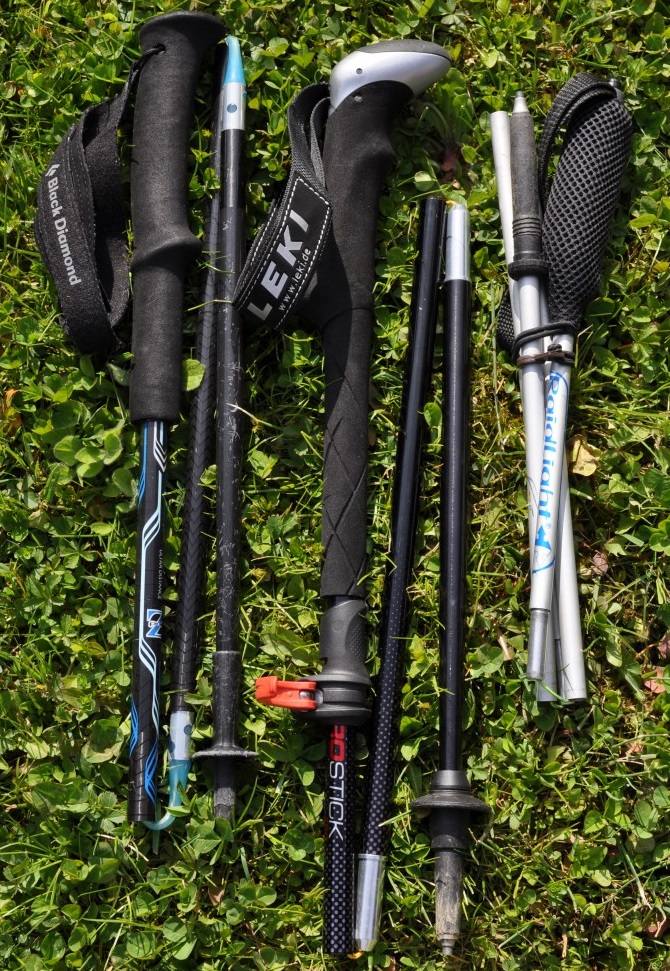
Overall the most compact hiking poles commonly on the market are the folding “tent-pole” style which collapses much shorter than traditional telescoping poles. The folding “tent-pole” style is fairly new and only gained traction just over a couple years ago and was popularized with Black Diamond’s Z-Pole line and followed by Leki’s Vario Line. Now just a few years later there are dozens of options from several manufacturers on the market.
The top performer in our review for compactness and packability is the Raidlight Foldable Trail, which pack down to a ridiculously short 12″ (30cm). While the Foldable Trail is far from the most versatile, they are the shortest of almost any functional pole we know of. The next most compact option is one of our top picks, the Black Diamond Distance Carbon Z and Black Diamond Distance Z, which still breaks down to less than half the length of other products with a minimum size of 14″ and offers zero adjustability. The Leki Micro Vario Carbon packs down to 14.5″ while the Leki Micro Stick, Leki Micro Vario Ti COR-TEC, and the Alpine Carbon Z pack down to the same size of around 15″ and all but the Alpine Z offer some adjustability. Even the longest of all these folding, “tent-pole” style products, is at least 9″ shorter than most of the telescoping poles in our review. The exception is the Komperdell C3 Carbon Compact, by far the shortest and lightest telescoping option, which packs down to 21.5″.
The Black Diamond Distance Carbon Z is crazy light and our favorite pole for light to medium duty use. It’s much lighter than the other top scoring poles and folds down to nothing. While it isn’t quite as versatile as many of the traditional telescoping poles, it is great for most backpackers and trekkers and is a stellar option for climbers.
The Leki Micro Vario Ti COR-TEC is a very packable pole that folds down to an impressive 15″. Not only does it feature our favorite grip among collapsible poles but it features our favorite handle in our entire review. Near the best factor of all, is that it’s on the less expensive side of all of the poles we tested at $140.
If packability is one of the most important features you’re looking for, then be sure to check out the shortest of the products mentioned above, but remember that most of these products have at least some compromise in adjust-ability and/or durability, especially the Raidlight, being killer for less aggressive day hiking and backpacking, but certainly less durable and likely inappropriate for most heavy duty uses. One nice thing about the Black Diamond Distance FLZ, Leki Micro Vario Ti COR-TEC, and The Micro Vario Carbon is that they are nearly as compact, all breaking down to around 15″ but all offer around 20 cm of adjustability. The Komperdell C3 Carbon compact, the most compact traditionally telescoping design has a maximum length of 120 cm, around 20 cm shorter than most comparably designed models in the review.
The Raidlight is the lightest and most compact trekking pole we tested. This makes it ideal for wingsuit BASE jumping. The Raidlight while super light and okay for light duty approaching and hiking, it’s likely not durable enough for most people’s everyday trekking and backpacking needs.
Overall Durability
We have broken a lot of poles during our testing as well as through the years we’ve been using them. The most common times we have broken them is when one punches through snow or into a gap between rocks and we bend or fall snapping the lowest or second lowest section. While all poles are far from being “break proof” some are certainly more durable than others. The biggest contributing factor to durability is shaft construction and material.
Shaft Materials
Aluminum
Aluminum poles typically use higher 7075-T6 or 7075-grade aluminum. Aluminum tends to be a little more durable; (being straight up beefier to begin with) and aluminum can bend and still be functional while carbon fiber has very little bend and will snap if pushed too far. Aluminum poles range from the lighter side being around 16 ounces per pair to around 22 ounces. One note of consideration is that not everyone needs a more durable product. If you are primarily day hiking or backpacking on trails, you can get away with a pretty light pole compared to bushwhacking with a heavy pack. We even used the Black Diamond Ultra Distance on lots of rocky, trail-less terrain, we were just more careful, and aware that we were more likely to break it while doing so.
Carbon Fiber
Carbon fiber construction makes the product lighter than their aluminum counterparts, with the heavier carbon fiber hiking poles weighing around the same as the lightest aluminum versions. While we do think that in general, aluminum products are more durable, in the grey area of all poles around 16 ounces, we think that beefier carbon fiber poles like the Black Diamond Alpine Carbon Cork or other heavier, sturdier carbon fiber options are at least as durable as other super lightweight aluminum poles that weight the same amount.
We tested both the durability of the shafts and the locking mechanism. The toughest contender in our review was the Leki Cristallo, Leki Corklite, Black Diamond Trail Ergo Cork and the Black Diamond Alpine Carbon Cork. Until you get below 13-15 ounces there isn’t a giant difference in durability with poles like the Leki Quantum being built to last a lifetime. Among the midweight poles, the Alpine Carbon Cork impressed us with their toughness. But once you start comparing poles below 13 or so ounces, the shaft durability becomes more suspect. Of the “Super Light Poles” the Black Diamond Distance Z seemed the most durable and WAY more durable than we expected and we used it for burly cross-country travel and it performed fantastically.
Other Pole Considerations
Pole Tips
Most poles use carbide or occasionally steel tips to provide traction. Carbide seems to wear a little better but both provide near equal traction on dirt, ice or snow. Many poles come with rubber or plastic tip protectors that be used to protect your tips. However, they are most effective for protecting your gear from your poles during travel or storage. If you plan to use your poles on asphalt a fair amount, consider buying a pair of poles that come with rubber tips or better yet separate angled rubber walking tips (sold separately) to help prevent premature wear of your tips and help increase the versatility of your poles.
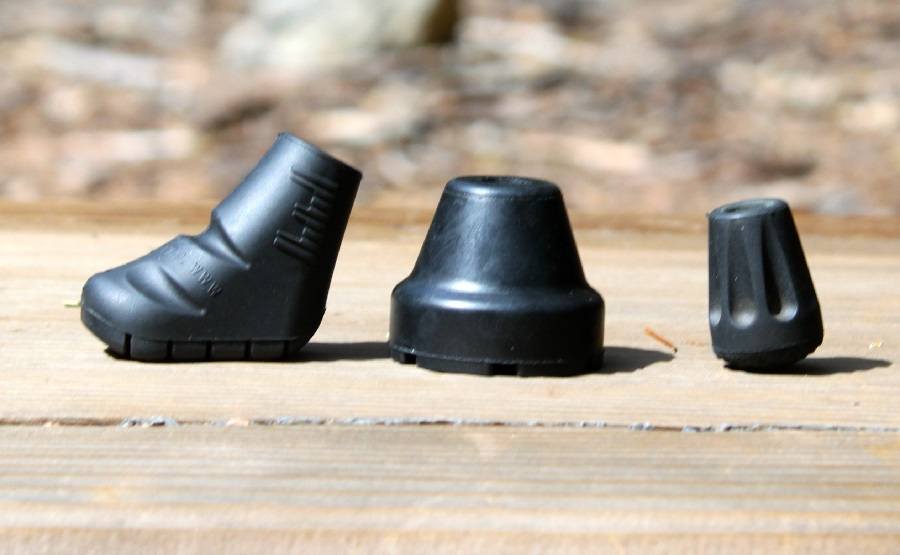
A cool feature a few lightweight options like the Black Diamond Distance Z-series poles have is their interchangeable tip options; a rubber coated tip that performed fine for normal on-trail hiking and great for use in more urban areas (like on concrete) and a more traditional carbide tip that works far better on steeper, muddier, or off-trail terrain. However many of the Distance Z poles don’t feature an interchangeable basket, fine for summertime use but inadequate for winter or mountaineering applications.
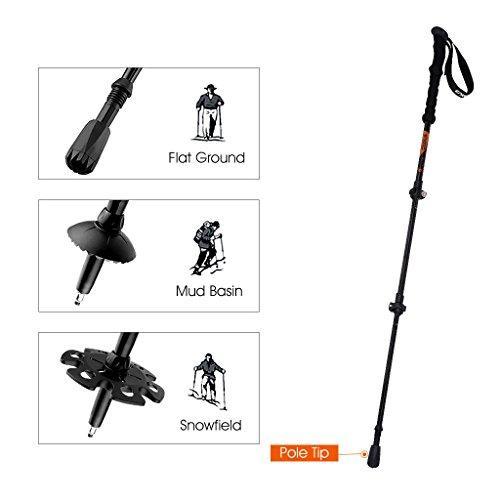
Baskets
Most of the hiking poles we tested featured removable baskets, with the exception of the Black Diamond Distance Z and Distance Carbon Z. Most manufacturers make two or three sizes of baskets, one trekking basket which is smaller and will help out with mud and won’t get hung up on branches and bushes. These trekking baskets are generally not suitable for snow and shouldn’t be used in such conditions because you risk your pole sinking deep unexpectedly and subsequently bending or snapping it. Snow baskets obviously offer superior float in snow but tend to get hung up more often while trekking through the forest and are marginally heavier.
Shock Absorbing Systems
After weeks of side-by-side comparison, we didn’t feel we needed them and felt there wasn’t much if any reduced fatigue at the end of long days (surprising right?) and didn’t like how they handled rough terrain where we were using our poles aggressively for balance. But with that said, there are some people who do really like them so we thought we’d report our findings here. Among the Shock-absorbing poles we tested, we liked the simple durable shock absorbing system of the Black Diamond Trail Pro Shock the best. It wasn’t a runaway winner, but we like the relatively light weight of the pole and its bomber shock system. We do also really like the REI Traverse Shocklight ($90) because what you get for the price is a pretty solid pole for $50 less than many other poles.
Accessories
If you plan on hiking in snow, it is important to change the baskets on your poles to designated snow baskets. The Leki Snowflake Basket is one option that performs well in snow.
Trekking Pole Tip Protectors add grip if used indoors and helps protect the tip if you planning on using your poles on the pavement.
The Leki LED Pole Light clips onto your pole to light the path when you are hiking at night.
Conclusion
Finding the perfect set of poles geared toward your hiking preferences isn’t an easy task. The best products in this category tend to be lightweight yet durable, feature strong locking mechanisms, save ounces and space, and are comfortable in hand for hours on end. But, these top-shelf products are also pricey, and, depending on where and how you hike, perhaps more than you actually need. It is our hope that our critical analyses of these models will provide positive assistance in your search for a new pair of hiking poles.



















